The process of understanding cancer stages in canines becomes essential for spotting cancer early and providing successful medical interventions. The advancement of dog cancers depends on the combination of cancer type and cancer severity. Early intervention provides dogs with their optimal chance to live a healthy life. Our analysis includes comprehensive details about the progression of dog cancer through every stage together with specific explanations of lymphoma in dogs stages and the progression of dog lung cancer.
What Are the Cancer Stages in Dogs?

Medical classification of dog cancers establishes their progression level based on the extent of body involvement. The staging progression starts at Stage 0 and extends up to Stage 4.
- At Stage 0 the dog contains precancerous cells which stay confined to their original location.
- At Stage 1 cancer remains small while it stays within its localized area.
- Round tumors expand while they start invading adjoining lymphatic tissue during Stage 2.
- At stage 3 cancer becomes either larger in size or spreads into several lymph nodes and body tissues.
- Stage 4 cancer of the canine body results in metastasis of cancer tissue to distant organs such as lungs, liver or brain.
The understanding of these cancer stages allows owners to plan necessary treatments and care protocols and emotional support strategies during each phase.
Stages of Dog Cancer Leading to Death

Cancer Stages in Dogs, a dog’s cancer death process starts after tumors gain invasive properties.
At first cancer cells present minimal danger but they escalate their dangerous growth patterns rapidly. Between the middle stages a cancer quickly metastasizes and damages vital body parts. The final stages of dog cancer destroy essential organs which produce extreme pain and lead to both life systems failure and significant deterioration of their quality of existence. It becomes necessary to closely watch symptoms at this point.
Final Stages of Osteosarcoma in Dogs
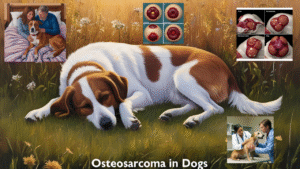
The final stages of osteosarcoma within dogs prove to be tragic for all involved. During advanced osteosarcoma dogs endure severe bone discomfort from painful swelling of tissues and developed problems with their mobility. The frequent occurrence of lung metastasis leads to worsening exchange difficulties for affected animals. The condition of weakened bones causes dogs to sustain fractures more readily. Medical professionals can determine that euthanasia should be used to prevent more discomfort during these excruciating stages.
Lymphoma in Dogs Stages
A typical pattern exists for how lymphoma progresses in dogs.
- Stage 1: One lymph node involved.
- During Stage 2 the disease affects several nodes located on a single side of the diaphragm.
- Stage 3: Nodes throughout body affected.
- Stage 4 lymphoma causes damage to both liver and spleen organs. This stage of dog lymphoma has spread to bone marrow or other parts of the body.
Performing early identification of different dog cancer lymphoma stages produces better prospects for effective chemotherapy intervention.
Canine Lymphoma Progression
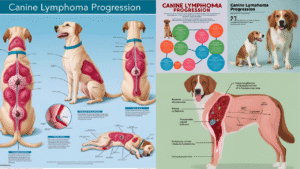
Without treatment the lymphoma cancer progresses quickly in dogs. The condition intensifies when mild swelling leads to complete multi-organ system failure. The transformation from ordinary symptoms to severe ones occurs rapidly during the dog lymphoma progression which takes approximately a few weeks to complete. The implementation of chemotherapy medical approaches extends survival time for dog lymphoma patients who receive treatment to experience a comparatively comfortable period extending from months to years.
Dog Mammary Cancer Stages

Dog mammary cancer stages develop according to the following pattern:
- Stage 1: Small, localized lump.
- Stage 2 presents itself through the existence of enlarged tumors which still have not migrated to lymph nodes.
- Stage 3: Tumor invades lymph nodes.
- During the fourth stage of cancer it spreads into both the skin and the chest wall.
- Stage 5: Distant metastasis (lungs, liver).
Surgical removal as well as chemotherapy provides increased survival chances for dogs that show signs of early mammary tumors.
Stage 1 Mast Cell Tumor Dog

Mast cell tumors remain at the localized stage when they appear during stage 1 in dogs. Cancer has not migrated to spread throughout the body. Surgical interventions are typically effective for curing first stage stage 1 mast cell tumor dog patients.
The detection of cancer at its early stages enables successful prevention of advancing to more serious growth stages.
Mast Cell Tumor Stage 2 in Dogs and Stage 3 Mast Cell Tumor Dog
Stage 2 mast cell tumor indicates that cancer has reached lymph nodes near the affected area. Unattended mast cell tumor dog cancers progress toward stage 3 mast cell tumors which cause extensive tissue and lymphatic system spread. Life expectancy undergoes significant extension when surgery links with chemotherapy as a rapid response.
The Terminal Condition of Mast Cell Cancer in Dogs
At the advanced stages of canine mast cell cancer the disease displays widespread internal growth. A mast cell cancer dog displays various signs including nonstop vomiting, bleeding from the stool and quick weight loss together with signs of internal bleeding. The main objective now switches from a cure to providing comfort to the patient.
Dog Lung Cancer Stages

There are three stages to consider when examining dog lung cancer.
- The early stage reveals only gentle coughing along with minimal breathing problems.
- During the middle stage of the disease dogs experience repeated coughing attacks in combination with weight loss symptoms and feelings of fatigue.
- Late: Coughing up blood, severe breathing problems.
- At the end stage of canine lung cancer dogs experience severe respiratory problems that typically lead to heart failure.
Final Stages of Spleen Cancer in Dogs
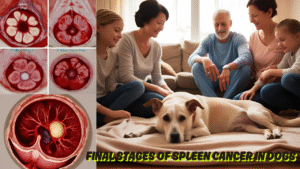
Spleen cancer in dogs intensifies into a condition where internal bleeding starts to occur during its final period. Dogs experience sudden collapses when their blood pressure drops because of significant bleeding amounts. Emergency surgery may prolong a dog’s life for a short period yet their survival outcomes become poor when treatment happens late.
Stage 1 Hemangiosarcoma in Dogs

The medical classification of a hemangiosarcoma in stage one indicates that the tumor remains confined inside its original location. A surgical procedure during this time period brings the highest opportunity for survival. Although spleen cancer usually detects too late since initial warning signs prove subtle.
Bladder Cancer in Dogs Stages
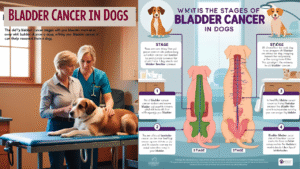
Dogs with bladder cancer experience the disease progression as follows:
- Early Stage: Difficulty urinating.
- Middle Stage: Bloody urine, incontinence.
- Late Stage: Metastasis to other organs.
Dogs’ survival rates rely heavily on how quickly medical professionals give their diagnosis.
Canine Bladder Cancer Stages
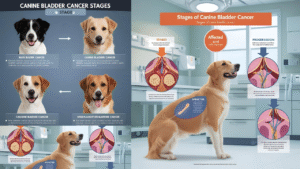
Dog bladder cancer follows the same sequence of progression as human bladder cancer does in its development stages. Bladder wall tumors initiate the cancer progression before metastasizing to lymph nodes followed by lung and bone involvement during last-stage development.
Canine Lymphoma Final Stages
Dogs at the final stages of canine lymphoma suffer the complete failure of their internal organs. The main symptoms during this time consist of general weakness followed by reduced appetite and heavy breathing. Life-threatening decisions about euthanasia often become necessary for owners since it helps prevent suffering.
Dog Brain Tumor Progression Timeline
A dog’s tumor development time in the brain depends upon both its location and specific tumor type. The pace at which gliomas evolve is faster than meningiomas do. The signs of this condition typically lead to seizures together with head pressing along with rapid unexpected behavioral changes. The timely detection of diseases enables patients to survive for longer duration.
Dog Liver Cancer Final Stages
The signs of dog liver cancer develop into jaundice at its most advanced phase. Vomiting along with diarrhea and extreme lethargy and weight loss are possible symptoms observed in dogs. The rapid symptom deterioration occurs because liver diseases disrupt multiple body processes.
Dog Mouth Cancer Stages
At the beginning of dog mouth cancer stages oral tissues develop small masses. During the early stages of dog mouth cancer the condition often causes nonspecific minor swelling. Liver tumors progress into operational and bleeding lesions which impair dogs’ ability to eat food. If dog cancer patients do not undergo surgical treatment the cancer cells will move from the original location toward jawbones and lymph nodes.
Dog Prostate Cancer End Stage
During its final stage the prostate cancer affects dogs with extreme pain that makes urination and defecation extremely troublesome. Walking and posturing become difficult. Advanced pain treatments together with euthanasia are both acceptable options for such cases.
Early Stage Bone Cancer in Dogs Xray
The xray of early stage bone cancer in dogs demonstrates modest lytic weak spots or thinning bone characteristics. The discovery of cancer during its early stages enables surgery along with chemotherapy to keep your pet alive while saving their limb.
Early Stage Mouth Cancer in Dogs
Dogs have a better chance of full surgical intervention when their mouth cancer is detected during its early stages. The delay of treatment causes deep tissue penetration as well as tooth loss and dangerous infections to occur.
End Stage Cancer in Dogs
By the end stage of canine cancer tumors have reached extreme levels of spread throughout the body. Most treatments are palliative. The decision to perform euthanasia appears as a choice to protect dignity while stopping excessive pain.
End Stage Lymphoma Dogs
The final stages of lymphoma in dogs bring frequent vomiting alongside diarrhea and breathing trouble as well as loss of responsiveness. Signs indicate quality of life has deteriorated to a great degree.
The Final Phase of Dog Nasal Cancer
In the later stages of nasal cancer dogs experience bleeding from the nostrils together with swelling of the face and worsened respiratory discomfort. The disease remains uncured even when palliative treatments succeed in decreasing symptoms.
Late Stage Cancer in Dogs
The diagnosis of late stage cancer proves to be difficult for dogs and their caretakers. Dogs face massive organ failure. The primary objective of palliative care is to help dogs manage their pain yet the success rate of cures remains minimal.
Lymphosarcoma in Dogs Stages
When dogs suffer from lymphosarcoma the disease advances speedily without proper treatment. The survival time reduces swiftly when lymphoma patients choose not to undergo early chemotherapy even though this treatment can achieve remission.
Cutaneous Malignant Melanoma Dog
A cutaneous malignant melanoma dog medical diagnosis results in the development of highly aggressive skin cancer. The cancer tends to metastasize into both lungs and liver tissues. The primary treatments include surgery and radiation and immunotherapy among them.
Last Stage of Lymphoma in Dogs
Dogs undergoing the last stage of lymphoma face continuous exhaustion alongside respiratory issues and failure of multiple organs. Compassionate end-of-life care becomes essential.
Grasping dog cancer stages provides both timely diagnosis and suitable treatment options as well as humane end-of-life care. Learning about the progression of every cancer type affecting dogs including lymphoma and spleen cancer as well as brain tumors enables you to deliver optimal care. Regular veterinary checkups along with hospitals visits should be conducted according to schedule plus immediate medical help should be sought whenever symptoms emerge.
1. What are the early signs of cancer stages in dogs?
In early cancer stages in dogs, you may notice small lumps, weight loss, or changes in behavior. Some dogs also show tiredness or slight lameness. Early detection can greatly improve treatment success.
2. What happens during the final stages of osteosarcoma in dogs?
During the final stages of osteosarcoma in dogs, pets experience severe bone pain, swelling, and breathing trouble. The cancer often spreads to the lungs, making quality of life very poor.
3. How fast does canine lymphoma progression happen?
Canine lymphoma progression can be very quick without treatment. Symptoms like swollen lymph nodes and weakness can worsen within weeks. Chemotherapy can slow down dog lymphoma progression significantly.
4. What is the survival rate for stage 1 mast cell tumor dog?
A stage 1 mast cell tumor dog often has a good prognosis. Surgery usually removes the tumor completely. Catching the tumor in the first stage prevents progression to mast cell tumor stage 2 in dogs or beyond.
5. How do the stages of dog cancer leading to death progress?
The stages of dog cancer leading to death usually start with mild symptoms like coughing or lumps. As cancer advances, organs fail, pain increases, and appetite drops sharply. Comfort care becomes important in the last stages of cancer in dogs.
6. What is the dog brain tumor progression timeline?
The dog brain tumor progression timeline depends on tumor type. Aggressive tumors grow and spread in months, causing seizures and behavior changes. Slow-growing tumors may take years to cause serious problems.
7. What are the symptoms of final stages of spleen cancer in dogs?
During the final stages of spleen cancer in dogs, symptoms like pale gums, weakness, sudden collapse, and internal bleeding are common. Emergency care is often needed, but survival chances are low.
8. How serious is stage 4 cancer in dogs?
Stage 4 cancer in dogs is very serious. Cancer has already spread to distant organs like lungs, liver, or brain. Treatment focuses on comfort rather than cure during this stage.
